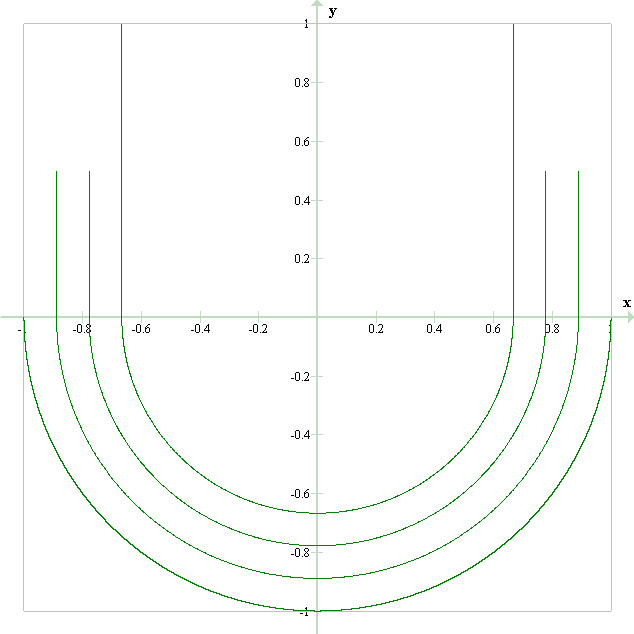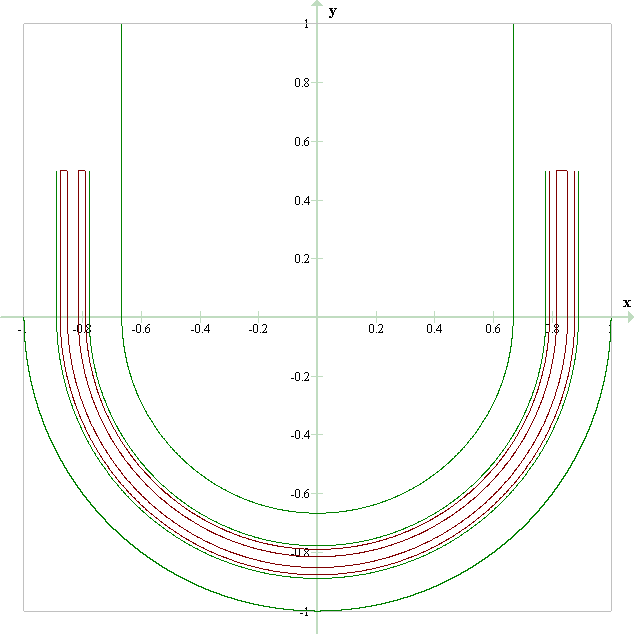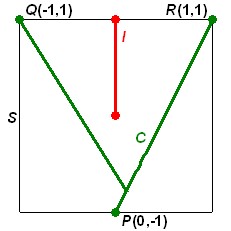I will answer my own question. The answer turned out the opposite to what I expected or hoped for, to my surprise, and I guess to Dominic van der Zypen's surprise. So, Lasse Rempe-Gillen's intuition worked better, he did guess the correct answer (see comments above, following the question), although he suggested a recursive construction without verifying the details, whereas what I came up with today is a pretty specific construction based on the Cantor set (and some $\sin\frac1x$ type curves). One could make a picture, which I do below since this is perhaps the easiest way to explain it.
Let $R$ be the "right half" of the usual middle third Cantor set, that is the intersection of the latter with $[\frac23,1]$. For each $r\in R$ the continuum $C$ that I will construct will contain the lower semicircle centered at the origin, of radius $r$. If $C_r$ denotes this (closed) semicircle, then the first picture below shows $C_1$, $C_{\frac23}$, $C_{\frac79}$, $C_{\frac89}$. (Note $\frac23=\frac69<\frac79<\frac89<\frac99=1$.) Each $C_r$ will be extended with a couple of vertical line segments at its endpoints, going up in the 1st and in the 2nd Quadrant. $C_{\frac23}$ will be extended with vertical line segments of length $1$, thus reaching the horizontal line $y=1$ (and intersecting it at points $(\pm\frac23,1)$). $C_{\frac79}$ and $C_{\frac89}$ will each be extended with vertical line segments of length $\frac12$. (I will comment on a formula that gives the exact length of the vertical line segments, depending on $r$, but I feel I should do that later.) $C_1$ will be the only one that is not extended (or formally extended with vertical line segments of length $0$). What was described so far is shown on the first picture below.

Corresponding to each middle-third $(a,b)$ that was removed in the construction of (the "right-half" $R$) of the Cantor set, we will add a "double $\sin\frac1x$ type" arc that "connects" the semicircles $C_a$ and $C_b$, including the attached vertical line segments. For example, for the middle-third $(\frac79,\frac89)$, this arc will alternate from points at height $\frac12$ in the 1st Quadrant to points at height $\frac12$ in the 2nd Quadrant, remaining all the time "between" $C_\frac79$ and $C_\frac89$ (with the attached vertical segments). One "end" of this arc will "approach" $C_\frac79$ (including its attached vertical segments), and the other "end" will "approach" $C_\frac89$ (with its attached vertical segments). This is illustrated in the next picture.

The main idea here is that if $K$ is any subcontinuum of $C$ (where $C$ is the continuum we are about to construct from all the $C_r$, attached vertical line segments, and connecting "double $\sin\frac1x$ type" arcs), and if $K$ contains the bottom point $P(0,-1)$ and at least one point on $C_\frac79$, then $K$ must also contain the connecting arc between $C_\frac79$ and $C_\frac89$. Since the "ends" of that arc "approach" $C_\frac79$ and $C_\frac89$, it follows that $K$ must contain both $C_\frac79$ and $C_\frac89$ (including respective vertical line segments). Such a subcontinuum $K$ must intersect the horizontal line $y=\frac12$ in both the 1st and the 2nd Quadrants (at points $(\pm\frac79,\frac12)$, $(\pm\frac89,\frac12)$, plus a bunch of points on the arc).
As a minor variation of this argument, $K$ might be a subcontinuum (of $C$) that does not contain any point of $C_\frac79$ (or of the respective vertical line segments), but does contain at least one point of the connecting arc between $C_\frac79$ and $C_\frac89$ (and also contains the bottom point $P(0,-1)$). In this case $K$ must contain just "one end" of the connecting arc: Namely, that end which approaches $C_\frac89$. It follows that in this case $K$ must contain $C_\frac89$ with
its vertical line segments. $K$ will be contained in the closed half-plane below the horizontal line $y=\frac12$, and will meet this line at
$(\pm\frac89,\frac12)$, plus a bunch of points on the arc (in both the 1st and in the 2nd Quadrant).
Continuing with the construction, we now add $C_\frac{25}{27}$ and $C_\frac{26}{27}$ along with vertical line segments of length $\frac14$ (reaching up to horizontal line $y=\frac14$). Note that $\frac89=\frac{24}{27}<\frac{25}{27}<\frac{26}{27}<\frac{27}{27}=1$, and $C_\frac{25}{27}$ and $C_\frac{26}{27}$ correspond to the endpoints of the removed middle-third $(\frac{25}{27},\frac{26}{27})$. We also add a "double $\sin\frac1x$ type arc" connecting
$C_\frac{25}{27}$ and $C_\frac{26}{27}$ (and attached vertical line segments), alternating between points at height $\frac14$ in the 1st and in the 2nd Quadrants. (Picture enclosed further down.)
Also, add $C_\frac{19}{27}$ and $C_\frac{20}{27}$ along with vertical line segments of length $\frac34$ (reaching up to horizontal line $y=\frac34$). Note that $\frac23=\frac{18}{27}<\frac{19}{27}<\frac{20}{27}<\frac{21}{27}=\frac78$, and $C_\frac{19}{27}$ and $C_\frac{20}{27}$ correspond to the endpoints of the removed middle-third $(\frac{19}{27},\frac{20}{27})$. We also add a "double $\sin\frac1x$ type arc" connecting
$C_\frac{19}{27}$ and $C_\frac{20}{27}$ (and attached vertical line segments), alternating between points at height $\frac34$ in the 1st and in the 2nd Quadrants.
$C_\frac{25}{27}$ and $C_\frac{26}{27}$ (with vertical line segments and connecting arc), and $C_\frac{19}{27}$ and $C_\frac{20}{27}$ (with vertical line segments and connecting arc) are illustrated at the next picture.

The continuum $C$ will consist of all lower semicircles $C_r$ for $r\in R$, together with respective vertical line segments, and with connecting arcs, as indicated above. (The precise length of the vertical line segments will be described, as was promised, further down. Hopefully the above description is clear enough, for now.)
If $K$ is any subcontinuum of $C$ that contains the bottom point $P(0,-1)$ and at least one point of the connecting arc between $C_\frac{25}{27}$ and $C_\frac{26}{27}$, then $K$ must contain at least "one end" of this connecting arc: At least the end which approaches $C_\frac{26}{27}$. It follows that in this case $K$ must contain $C_\frac{26}{27}$ with
its vertical line segments (reaching height $\frac14$). Such a $K$ will meet the horizontal line $y=\frac14$ at least at
$(\pm\frac{26}{27},\frac14)$ (plus a bunch of points on the arc) in both the 1st and in the 2nd Quadrant.
Similarly, if $K$ is any subcontinuum of $C$ that contains the bottom point $P(0,-1)$ and at least one point of the connecting arc between $C_\frac{19}{27}$ and $C_\frac{20}{27}$, then $K$ must contain at least "one end" of this connecting arc: At least the end which approaches $C_\frac{20}{27}$. It follows that in this case $K$ must contain $C_\frac{20}{27}$ with
its vertical line segments (reaching height $\frac34$). Such a $K$ will meet the horizontal line $y=\frac34$ at least at
$(\pm\frac{20}{27},\frac34)$ (plus a bunch of points on the arc) in both the 1st and in the 2nd Quadrant.
Re the exact length of the vertical line segments, the main idea here is a well-known continuous map from the product space $2^{\mathbb N}$ (where $2=\{0,1\}$ with the discrete topology, and $\mathbb N=\{1,2,3,\dots\}$) onto the unit interval $[0,1]$.
To make things precise, if $s=\langle s_1,s_2,s_3,\dots\rangle\in2^{\mathbb N}$ then one defines $\displaystyle\varphi(s)=\sum_{n\in\mathbb N}\frac{2s_n}{3^n}$. Then $\varphi$ is a homeomorphism between $2^{\mathbb N}$ and the usual middle-third Cantor set. For example $\varphi\langle 0,1,1,\dots\rangle=0+\frac29+\frac2{27}+\cdots=\frac13$ and $\varphi\langle 1,0,0,\dots\rangle=\frac23+0+0+\cdots=\frac23$.
One also defines a continuous $\psi$ from $2^{\mathbb N}$ onto $[0,1]$ by
$\displaystyle\psi(s)=\sum_{n\in\mathbb N}\frac{s_n}{2^n}$.
Note that
$\psi\langle 0,1,1,\dots\rangle=0+\frac14+\frac18+\cdots=\frac12=\frac12+0+0+\cdots=\varphi\langle 1,0,0,\dots\rangle$.
That is,
$(\psi\circ\varphi^{-1})(\frac13)=\frac12=(\psi\circ\varphi^{-1})(\frac23)$. The map $\psi\circ\varphi^{-1}$ is a continuous map from the usual middle-third Cantor set onto the unit interval $[0,1]$ such that, for each removed middle-third, both its end-points are sent to the same point in $[0,1]$. (As illustrated above, both endpoints of $(\frac13,\frac23)$ are sent to $\frac12$.)
The length of the vertical line segments attached at each $C_r$ is, essentially, given by the map $\psi\circ\varphi^{-1}$, with some adjustment.
Instead of sending $\frac13$ and $\frac23$ to $\frac12$, we would like to send $\frac79$ and $\frac89$ to $\frac12$. Also, larger $r\in R$ are sent to smaller height, like $\frac{25}{27}$ and $\frac{26}{27}$ are sent to $\frac14$, while $\frac{19}{27}$ to $\frac{20}{27}$ are sent to $\frac34$. Formally, what I think works, is to send $r\in R$ to $(\psi\circ\varphi^{-1})(3(1-r))$. For example when $r=\frac79$ we have $(\psi\circ\varphi^{-1})(3(1-\frac79))=(\psi\circ\varphi^{-1})(3\cdot\frac29)=(\psi\circ\varphi^{-1})(\frac23)=\frac12$. When $r=\frac89$ we have $(\psi\circ\varphi^{-1})(3(1-\frac89))=(\psi\circ\varphi^{-1})(3\cdot\frac19)=(\psi\circ\varphi^{-1})(\frac13)=\frac12$. When $r=\frac23$ we have $(\psi\circ\varphi^{-1})(3(1-\frac23))=(\psi\circ\varphi^{-1})(3\cdot\frac13)=(\psi\circ\varphi^{-1})(1)=\frac12+\frac14+\frac18+\cdots=1$. When $r=1$ we have $(\psi\circ\varphi^{-1})(3(1-1))=(\psi\circ\varphi^{-1})(0)=0$. All these values agree with the heights of the vertical line segments from our initial less formal description.
(As a side remark, in my question I required that the continuum $C$ must contain the points $Q(-1,1)$ and $R(1,1)$. The continuum $C$ that I described in this answer does not contain these points, but to rectify this, we only need to add the horizontal line segments from the point $(\frac23,1)$ to the point $(1,1)$, and from the point $(-1,1)$ to the point $(-\frac23,1)$. I prefer instead to work with the more relaxed version as stated towards the end of the question, requiring $C$ to intersect the horizontal line $y=1$ in both the 1st and the 2nd Quadrants, but not necessarily at $Q(-1,1)$ and $R(1,1)$.)
Note that for every $z\in(0,1)$ the continuum $C$ constructed in the present answer will contain a subcontinuum $K_z$ such that $P(0,-1)\in K_z$, and $K_z$ intersects the horizontal line $y=z$ and is contained in the closed half-plane below this line. Specifically, $K_z$ will consist of all $C_r$ with $r\in R$ (the right-half of the middle-third Cantor set) such that
$(\psi\circ\varphi^{-1})(3(1-r))\le z$, along with respective vertical line segments, and necessary connecting arcs. (The set of these $r$ will be of the form $[r_0,1]\cap R$ for a suitable $r_0$, namely $r_0$ would be the solution of the equation $(\psi\circ\varphi^{-1})(3(1-r))=z$ for $r$ in terms of $z$. For most $z\in(0,1)$ this solution will be unique. For countably many values of $z$, there will be two solutions, so in this case $K_z$ will not be uniquely determined. More precisely, if $z=\frac p{2^k}\in(0,1)$ for some integers $p,k$ (we may assume that $p$ is odd) then there will be a middle-third $(r_0,r_1)$ such that $(\psi\circ\varphi^{-1})(3(1-r_1))=(\psi\circ\varphi^{-1})(3(1-r_0))=z$. One could come up with a precise formula, but perhaps this is unnecessary.)
(Credit goes to Ivan Johansen for his Graph
https://www.padowan.dk/ , which I used to make the pictures.)
P.S. I am tempted to call the continuum $C$ described above the Neptune Trident. This might be a little imprecise since the middle dent is missing
(but the more precise "bident" or "polydent" just don't sound right). At hindsight the construction wasn't overly difficult and perhaps $C$ does not need a special name, but it doesn't hurt to propose one.





